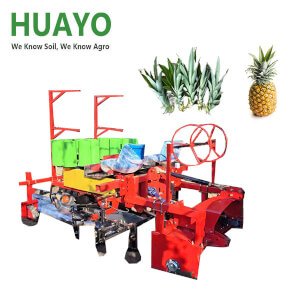What Equipments Should You Prepare Before Transplant Pineapple?
Before transplanting pineapples, it’s essential to have the right equipment to ensure efficient planting and healthy growth. Here’s a list of key tools and machinery you should prepare:
1. Pineapple Transplanter:
- Purpose: A specialized machine designed for transplanting pineapple suckers or seedlings into the soil.
- Why: It ensures uniform spacing, depth, and quick planting, minimizing labor and increasing planting efficiency.
HYZP-2 Pineapple Seedling Transplanter from HUAYO AGRO

2. Tractor or Towed Vehicle:
- Purpose: To pull or tow the transplanter, especially if it’s a tractor-mounted model.
- Why: It provides the necessary mobility to transport the transplanter across the field.
3. Land Preparation Equipment:
- Rotary Tiller or Plow: To prepare the soil before transplanting. These tools break up compacted soil, improving aeration and drainage.
- Ridge Maker or Bed Maker: For creating raised rows or ridges in the soil. Pineapple plants thrive in raised beds, which enhance drainage and root growth.
4. Irrigation System:
- Drip Irrigation: A system that provides consistent water directly to the root zone of each plant.
- Water Tank or Pump: To ensure a steady water supply for irrigation, especially in dry areas or where rainfall is unreliable.
5. Fertilizer Spreader:
- Purpose: For applying fertilizers efficiently before or during the planting process.
- Why: Fertilizers are essential to provide the nutrients pineapples need for healthy growth and development.
6. Mulching Machine (Optional):
- Purpose: For laying down mulch after planting, which helps retain soil moisture, suppress weeds, and improve soil temperature.
- Why: Pineapples thrive in controlled soil moisture and temperature, and mulching supports this.
7. Planting Tools (Manual):
- Hand Tools: For those planting manually, a sharp knife for cutting off pineapple suckers and a hoe or trowel for digging holes might be necessary.
- Planting Bags (Optional): To transplant pineapple suckers or seedlings into the field, especially if they were initially grown in a nursery.
8. Personal Protective Equipment (PPE):
- Gloves, Boots, and Safety Gear: Protect yourself from any sharp edges, harsh weather, or soil-borne diseases during the planting process.
9. Soil Testing Kits (Optional):
- Purpose: To ensure the soil has the right pH and nutrient content before planting.
- Why: Pineapples prefer slightly acidic soils (pH 4.5 – 6.5), so testing can help adjust the soil conditions for optimal growth.
10. Marking Tools:
- Purpose: For marking rows and distances for consistent plant spacing.
- Why: Proper spacing is essential for pineapple growth, as overcrowded plants can stunt growth and reduce yields.
Preparation Tips:
- Check Soil Health: Ensure the soil is well-drained, loose, and rich in organic matter.
- Ensure Equipment Functionality: Check that your transplanter, irrigation system, and all equipment are in good working condition before starting the operation.
- Weather Considerations: Plan for transplantation during the rainy season or ensure irrigation is available to prevent transplant shock.


By ensuring you have the right equipment and preparing properly, you’ll create an environment that promotes healthy pineapple growth and a successful harvest.
HYZP-2 Pineapple Seedling Transplanter







